Sudden redness in the whites of the eyes may appear suddenly and be accompanied by a feeling of swelling or irritation in the eye, and this is likely the result of inflammation. In addition, redness in the eyes can indicate the presence of a variety of health problems.
These problems vary, while some are simple and easy to treat, to more complex and serious problems that require medical intervention. Eye redness can be the result of dilation of tiny blood vessels, which may be found between the solid part of the eye and the clear mucous membrane at the top of the eye.
In the case of sudden eye redness that is accompanied by pain or a change in vision, it can be associated with visual problems and diseases that require immediate medical attention.
Environmental causes of sudden eye redness
Many environmental factors are major causes of sudden eye redness, including:
- Air allergies: Some allergens in the air, such as pollen, can cause eye irritation.
- air pollution: This includes air pollution due to automobile exhaust and emissions from factories.
- Smoke entering the eye: Smoke associated with fire and fires, as well as cigarette smoke, can be a cause of redness.
- Dry air: Air that does not contain water droplets, as occurs in some dry climates and in airplane cabins.
- Dust and dirt particles: The presence of dust and dirt can cause eye redness.
- Airborne vapors: Such as benzene, solvents and thinners.
- Exposure to volatile chemicals: Such as chlorine in swimming pools and pesticides.
- Excessive exposure to sunlight: Especially without wearing sunglasses that protect from ultraviolet rays.
Eye redness resulting from these factors indicates environmental influence on the eye, and it is preferable to take preventive measures and identify the causes of irritation to avoid recurrence of this condition.
Types of infections that cause sudden eye redness
Indeed, eye conditions may be diverse, and some may be more susceptible to redness. Among these cases, we find:
Dry Eye:
Some people suffer from chronic hypohydration and lack of moisture on the surface of the eye. Dry eyes can cause mild irritation or even persistent, severe inflammation. This condition can lead to:
- atoTHAB AtoQRNYH: Which may be responsible for sudden redness in the eye.
2- Air pollution: This includes air pollution due to car exhausts and emissions from factories.
3- Smoke entering the eyes: Smoke associated with fire and fires, as well as cigarette smoke, can be a cause of redness.
4- Dry air: air that does not contain water droplets, as happens in some dry climates.
5- Dust and dirt particles: The presence of dust and dirt can cause eye redness.
6- Airborne vapors.
7- Exposure to chemicals: such as chlorine and pesticides.
8- Excessive exposure to sunlight: especially without wearing sunglasses that protect against ultraviolet rays.
In these cases, medical intervention is necessary, and it is important to consult a doctor to determine the causes and treatments for these conditions, especially if they cause frequent or persistent eye redness.

Inflammation resulting from eye allergies
When focusing on eye allergies, we find that in addition to the symptoms of sneezing, congestion, and leaking discharge from the nose, most individuals with allergies can also experience a sudden feeling of itching in the eyes, which leads to increased tear production, and after that, redness can occur. In the eye and swelling of the eyelids.
In some cases, eye allergies may play an important role in conjunctivitis, also known as pink eye, which occurs in the context of exposure to other eye infections and inflammation.
Types of eye drops and the most important tips for using them
Bacterial or viral conjunctivitis
This may be the result of infection with viruses, as there is a type of conjunctiva virus similar to the virus that causes the common cold. This type is strongly associated with infection, but usually disappears on its own within several days without the need for medical treatment.
On the other hand, bacteria can cause serious damage to the eye if left untreated.
Allergic conjunctivitis
It is known as a type of allergy called allergic conjunctivitis. This inflammation can be seasonal due to exposure to pollen, such as allergic rhinitis and asthma. For example, there can be an accelerated reaction in the spring due to increased amounts of pollen in the air.
At the same time, inflammation can be a constant presence throughout the year due to constant exposure to such environmental dust and pet dander. This type of allergy can cause allergic conjunctivitis and show signs of itching in the eyes and increased tear production.
Wearing contact lenses:
Contact lenses may affect the color of the whites of the eyes, causing sudden redness resulting from various eye infections. This should be taken into consideration when using contact lenses, as some infections can cause this effect.
Digital eye strain:
Digital eye strain is caused by the use of computer screens, which leads to severe fatigue of the cornea and conjunctiva. Measures should be taken to reduce this stress, such as visual comfort and protection techniques during prolonged use of the screen.
BruisesOr eye injury:
Accidents and bruises can occur that mainly affect the eye. It is emphasized that more than 90% of these bruises can be avoided by taking the necessary precautions.
Eye ulcer:
In most cases, ulcers appear on the cornea as a result of a bacterial infection that attacks the cornea. It often occurs after injuries or bruises to the eye. This point must be taken into account and the necessary preventive measures taken to maintain eye health.
When is red eyes a disease?
Of course, sudden eye redness can be diagnosed as a serious health problem, and you should immediately begin treating it. Among the signs to consider:
- If redness persists for more than 10 days without any improvement.
- If you notice any changes in your vision such as cloudiness.
- If you feel severe pain in your eyes.
- If your eyes become more sensitive to light.
- If you notice discharge from one or both eyes.
- If you are taking medications that affect blood clotting, such as heparin or warfarin (Coumadin, Jantoven), which may cause pathological redness in the eye.
- If there is a headache and blurred vision accompanying the redness.
- If you start seeing rings or white circles around lights around you.
The Royal Spanish Center can be consulted immediately if any of these signs are present to evaluate the condition and determine the appropriate treatment through the center’s best treatment methodology.

